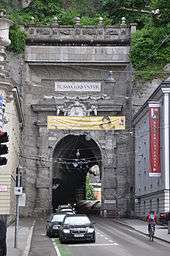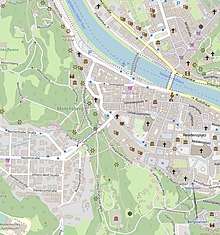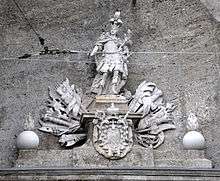Sigmundstor, Salzburg
The Sigmundstor, generally known as the Neutor, is a tunnel in Salzburg built in the 18th century. 131 metres long,[1] connecting the Altstadt with the Riedenburg quarter, it is the oldest road tunnel in Austria. After the 64-metre Urnerloch in the Gotthard Pass (Switzerland)[2] and the eastern bore of the Ilzdurchbruch in Passau (Bavaria) it is the oldest known road tunnel in Europe. In earlier times it was also one of the city gates of the historic Altstadt. From 1916 to 1940 a tramline ran through it, and since then it has formed part of a route of the trolleybuses in Salzburg.

Earlier projects


In 1675 the court commissioner of buildings Michael Springrueber approached Hofkriegsrat Guidobald Franz Freiherr von Hegi with a proposal to improve the fortifications protecting the central areas of Salzburg city, cutting the Mönschberg ridge in two, and connecting the parts with a drawbridge. This would prevent any enemy that had succeeded in taking the Monika and Augustiner forts from making its way along the Mönschberg right up to the outer works of the castle and from bombarding the old town from the heights.
In 1676 Hegi made the same proposal to the Prince-Archbishop of Salzburg, Max Gandolph von Küenburg and set out to see whether the Mönchsberg could indeed be cut at its narrowest point. In this proposal he mentioned for the first time the utility of the project for allowing the expansion of the city. The valley lowlands of Riedenburg could be made accessible by means of the cut and could allow room for settlers from the old town; the new district would also be militarily easy to secure.
From 1676 until Max Galdolf’s death in 1687 excavations proceeded and a 35m wide cut was made in the mountain before work was abandoned as uneconomical. Traces of this work can still be seen today near the concert hall and in the lookout terrace cut into the rock above the Sigmundstor.
Construction
In 1759 the commissioner of buildings Elias Edler von Geyer again suggested a cut through the Mönchsberg to the then Prince-Archbishop Sigismund von Schrattenbach. After delays caused by concerns about its feasibility the project began on 14 May 1764.[3] Digging started on both sides of the mountain and on 2 September 1765 the dividing rock between the two excavations was broken. The work cost 19, 820 Gulden, including 11, 538 Gulden on the gateways alone.
The excavation of the 135m long tunnel, 5.5m wide and 7m high produced around 4,500 m³ of waste stone which was used for roadbuilding. The tunnel is dug at an 8% inclination, which helps natural light illuminate it.[4]
Decorative features
The facades at both ends of the tunnel were from an architectural design by de:Wolfgang Hagenauer with the sculptures by de:Johann Baptist Hagenauer.[3]
the eastern entrance

At the tunnel entrance on the old town side an inscription was carved over a bas-relief of the Prince-Archbishop with the words Te saxa loquuntur (“The stones will speak of you.”). Originally the structure of the baroque horsepond with its frescoes extended in front of the current eastern gate, giving the square a symmetrical form. A decorative gate within that structure led under cover to the present gate at the head of the tunnel. Thus structure was demolished around 1860.[3]

The western entrance

The western entrance on the Riedenburg side has a statue of the martyr Sigismund of Burgundy (†524) above war trophies and the Schrattenbach crest.
The inscription there reads: “D(eo) O(ptimo) M(aximo) - D(ivino) Sigismundo M(artyri) publico bono, commodo decori. SIgIsMVnDI ArChIepIsCopI SaLzVrgensIs P(rincepis) S(acri) R(omani imperii) comitib(us) de Schrattenbach aeternae memoriae W(olfgangus) Hagenauer archit(ectus)“ The capital letters in the inscription, added together, come to 1767.
The plinth of the statue carries the inscription “Joan(nnae) Hagenauer inv(enit) exc(ussit) et eff(ecit)“ (“Johann (Baptist) Hagenauer discovered, hewed it out and completed (this statue)“).
Proposed defensive ruin
The original plan included the construction of a military outer structure on the Riedenburg side in the form of a park of ‘ruins’, then fashionable.[5] These constructed ruins were to vote the memory of the Roman settlement of Juvavum and symbolise the long history of the city of Salzburg. Because of the death of Prince-Archbishop Sigismund in 1772 nothing more than a pair of obelisks as ever completed. Johann Baptist von Hagenauer was sacked after a quarrel with the thrifty new Archbishop Colloredo, although his brother continued to serve as the court director of buildings.
The former Zwinger in front of the west gate
Until around 1860 the Sigmundstor was defended on its western side by a fortified defensive Zwinger, including a defensive wall, guardhouse and tollbooth, surrounded in three sides by a moat with drawbridges. The tunnel itself could be defended with a palisade in the event of attack.
Contemporary significance
Today the Sigmundstor with two narrow lanes of traffic is an important transport route, often full of vehicles during the Salzburg Festival when the city is busy. To the north of the main tunnel is a small parallel tunnel for pedestrians and cyclists, built in 1968/9.[6] From this an access tunnel extends to the northern old town garage under the Mönchsberg. On the southern side a similar tunnel extends to the southern garage and to the concert hall itself.
The original name of the tunnel was never popular among the townspeople. Only in 1990 was the designation “Sigmundstor” more widely adopted, when the square on the old town side, Sigmundsplatz, (named after Sigismundus Christoph von Schrattenbach) was renamed in honour of the recently deceased conductor Herbert von Karajan. More commonly however the people of Salzburg refer to it as the “Neutor” (“New Gate”) and indeed the street that leads to it is known as the “Neutorstraße“.
The tunnel underwent major restoration works in 1985/6 and 2009.[3]
Before the 2019 city council and mayoral elections the SPÖ, NEOS and the Grüne proposed to ban private cars from the Sigmundstor. However after losing the first round of voting the SPÖ distanced itself from this proposal.[7]
Bibliography
- Adolf Hahnl: Das Neutor (Schriftenreihe des Stadtvereins Salzburg. Kulturgut der Heimat. Book 6, ZDB-ID 842494-9). Stadtvereins Salzburg, Salzburg 1977.
- Clemens M. Hutter: Das Neutor ist mehr als ein „Loch im Berg“. Bastei – Magazin des Salzburger Stadtvereins, 2018, vol. 67 pages 34–35.
- Reinhard Medicus: Die alten Wehrbauten der Stadtberge. In: Christian F. Uhlir (ed.): Salzburger Stadtberge. Mönchsberg, Kapuzinerberg, Festungsberg, Nonnberg und Rainberg. edition winterwork, Borsdorf 2011, ISBN 978-3-86468-033-5, pages 138–157
References
- "Sigmundstor". structurae.net. Structurae.net. Retrieved 12 August 2019.
- "Berge und Pässe der Alpen". www.alpenpass.eu.
- "Te saxa loquuntur – Von Dir sprechen die Steine: Das Salzburger Neutor". bda.gv.at. Bundesdenkmalamt. Retrieved 12 August 2019.
- Bittmann, Julius (5 June 2010). "Ein Meisterwerk der Kunst und der Technik". Traunsteiner Tagblatt. Retrieved 12 August 2019.
- "Projektliste Ungebautes Salzburg". initiativearchitektur.at. Museum der Moderne, Salzburg. Retrieved 12 August 2019.
- "Siegmundstor / Neutor". kulturerleben.salzburgresearch.at. Discovering Salzburg's Cultural Heritage. Retrieved 12 August 2019.
- "SPÖ rudert zurück: "Keine Neutor-Sperre"". ORF Salzburg. Retrieved 2019-03-13.